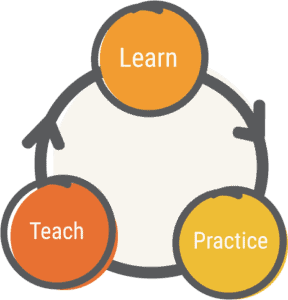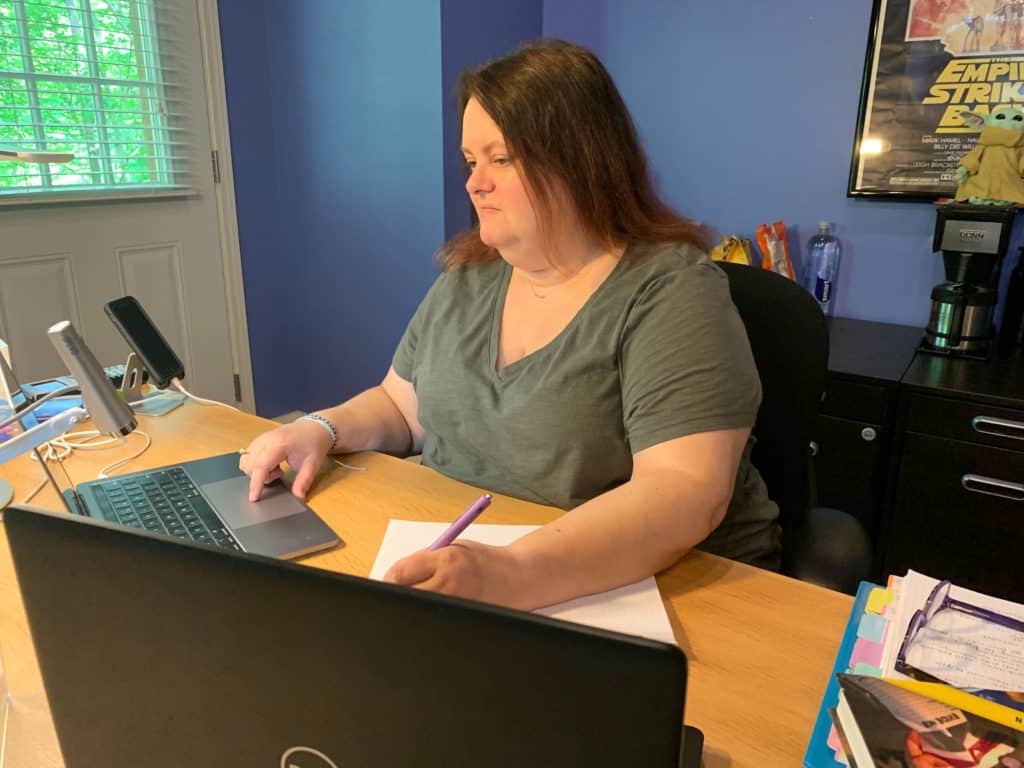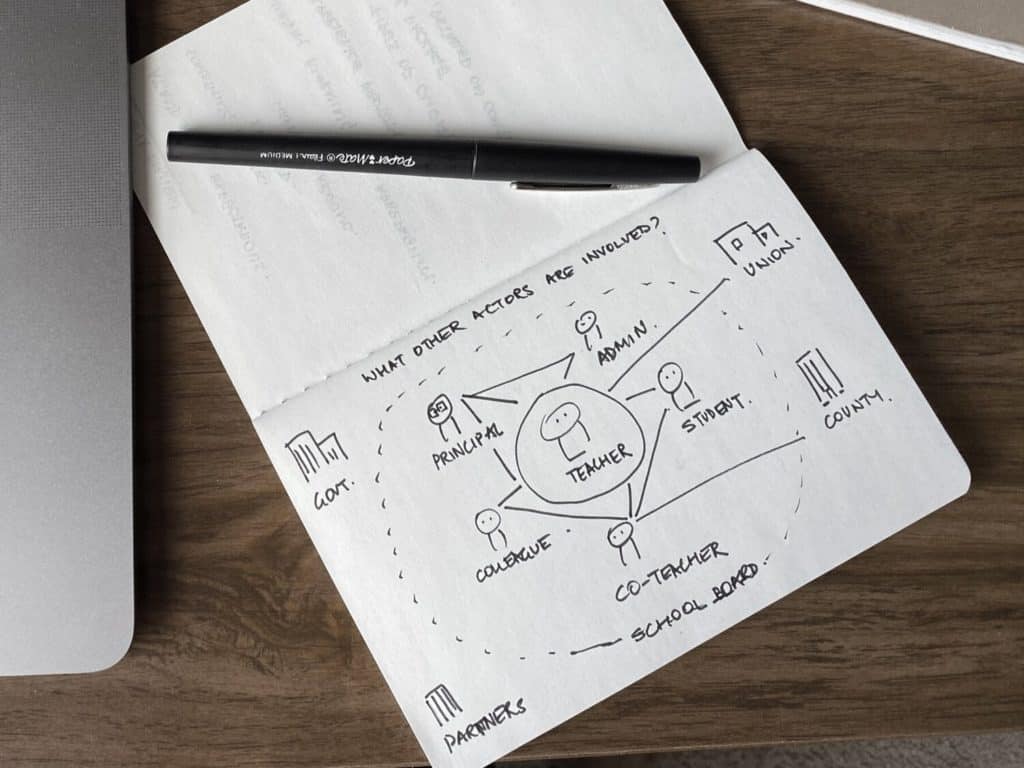
At Harmonic, we believe in continuously expanding the practice of design. Every day, we learn from our peers, clients, interns, and partners. We teach others how to use service design to create better outcomes in their organizations and society. This cycle of learn-practice-teach is integral to our work and why we do what we do.
All of us owe a lot to the teachers in our lives that shaped our minds, helped build our practice, and mentored us as people. We thought of them recently with the annual marking of National Teachers Week. In celebration of those who nurtured our thinking and shaped the personality we embody today, we decided to chat with a few teachers in our immediate circle. We were curious—what are they doing in their classrooms today that we could learn from to improve our practice?

An inspiration to kids from elementary to high school, Susan Taylor, Robert Weatherly, and Kara Harris shared both their classroom and virtual experiences with us. It wasn’t until we dived deep into their professional lives that we discovered how strikingly similar our work and practices are. Here are some thoughts and best practices to create better learning and teaching experiences.
Teaching today (for the most part) has evolved from lecture-style schooling to activity-based interactive learning. Teachers go the extra mile to spend time outside of their work hours to prepare for their sessions, making them fun and interactive for students. Learning is no longer confined to the four walls of the classroom; it’s engaging, experimental, and very hands-on, much like our work in service design.
“We have to plan a workshop every day of the workweek. An hour to pull it all together, to engage a bunch of elementary school kids with different skills, abilities and a whole continuum of behaviors trapped in a box all day long ”
Susan
Designers often spend hours crafting engaging workshop experiences for participants that stimulate creativity and collaboration. However, one may still end up with a low-energy or a distracted group that makes it harder to go through the day as planned. Public school teachers have an advantage—they get to know their students over time and can adapt their teaching style based on that knowledge. So how might we take a similar approach? Work harder at getting to know our workshop participants before designing a session. Understand what excites them. Learn where their interests lie. Uncover what part of the project is most valuable to them. Then, design your interactions to meet them where they are. This will increase your odds of delivering greater value in this collaborative experience.
“Most of my planning period is spent in staging a crime scene for a forensic science lab. I plant fingerprints, fake blood, and DNA samples for the kids to run tests on.. ”
Kara
Curious about how these teachers keep the energy up throughout their sessions? Keeping spirits high and creativity bulbs shining bright is sometimes harder than facilitating the activity itself. This requires soft skills on the facilitator’s part, identifying where and why the interest of the group is dropping, and hard skills to ensure that they can quickly pivot and design an impromptu energizer to lift the energy back up.
Teachers acquire these skills through their years of experience dealing with a new set of participants (i.e., students) every semester. Facilitators like us could greatly borrow these skills to gauge the engagement level in the room and act accordingly.

Much like how our work in service design, teachers’ value their relationships with their students and coworkers as one of the most rewarding aspects of their profession. Connecting with the students at different levels, understanding where they are coming from and what their needs and behaviors are and using this understanding to meet them where they are, is an important part of a teacher’s day-to-day life. Most teachers take up this profession because of their love for creating bonds with kids of different age-groups. They are fascinating creatures as some teachers say. The more they know the students, the easier it becomes to identify individual students’ limitations and help them accordingly.
“One of the best things is when a student, ten years later, comes back and tells you that you were their favorite teacher.”
Kara
A major portion of the responsibilities that service designers take up in any project involves sensemaking of organizational dynamics and navigating through the complexity within. To paint the right picture of the client ecosystem, service designers inject themselves into the organization and build relationships with the right people who can serve as an ally throughout the process and our time on the project. These relationships foster transparency, manifest trust, and enhance the change process.
“ I miss the interaction with the kids so much and now that we’re all virtual learning, sometimes I don’t want to see them go at the end of our zoom session”
Robert
Storytelling is a powerful tool when it comes to learning. We have learned about the world in the form of stories. We comprehend reality in stories. This continues even today as teachers attempt to curate their sessions to relate them and follow through what they taught the day before. This continuity enhances their absorbing capabilities and brings value to their learning process making it easy to understand and dissipate knowledge. Building those muscles early opens up a world of possibilities and perspectives to view things around us.
“He (Robert) is applying his personal interest to his schoolwork. He is making his own interactive maps and writing songs to teach the names of countries and their capitals to kids.”
Vanessa
Our work depends heavily on narratives. Service designers craft similar narratives in their design approach and during the final delivery to better tie up the work done and make it easy to carry forward for stakeholders within various cross-functional teams. These narratives serve as powerful tools to bring an actor’s service experiences to life and help tie them to a team’s strategic decision-making process. It aligns different teams around a desired future-state experience and serves as a robust tool to continue creating buy-in across the entire organization.
Stories produced with just the right level of detail have the ability to spark strategic discussions on what this experience is, how it can be made real and how it will fit in the greater ecosystem of the existing service offerings. As Carl Alviani mentioned in his medium article if it makes a good story, it’s going to make a good experience.
As a by-product of my conversation with the teachers coupled with a few thoughts floating around in my head, I realized how quickly we segued into a discussion about the need for change in the current education and school system.
“We know education systems to be better than this. Designers need to investigate what is going on and why no one is designing education the right way.”
Susan
Change is hard, and, let’s face it, the education system is a pretty good example of that. How many of us service designers have had the opportunity to work on improving the way education is delivered, concepts are crafted, and experiences are curated in schools? It is not every day that these school systems approach designers like us to rethink their service delivery. Time and budget are two of the biggest barriers in this field of work. Things in this area are changing, but they are not changing fast enough.

My conversation with these teachers made me consider the possibility of them becoming change initiators in their schools. Having the right mindset and being in the right context makes them one of the best candidates to drive and sustain change in the school ecosystems. With just enough knowledge and experience with using service design tools and methods, teachers can effectively become the voice of change, evolving their schools to a better future.
“People want answers. They want to know what I am doing and what is the impact of it. For them, it’s all about data and test scores”
Robert
Having said that, the challenges don’t end there, especially with this new way of teaching. Students are no longer required to attend online classroom sessions. Amidst the chaos associated with this pandemic affecting their work life, parents do very little to reinforce the importance of schooling. Zoom meetings are exhausting, tools are hard to understand, transferring data is complex. All these added to the already existing challenges are making it even harder for teachers to perform their tasks. But guess what—they are doing an excellent job at it.
So, here’s to all the inspiring, visionary, and hardworking champions disguised as teachers, Harmonic wishes you a Happy Teacher’s Week!